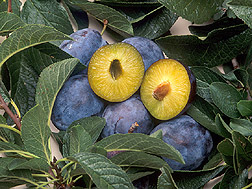This page has been archived and is being provided for reference purposes only. The page is no longer being updated, and therefore, links on the page may be invalid.
|
|
Plum-Pox-Resistant Trees Move Forward
By Kim KaplanJuly 25, 2007
Plum trees with resistance to plum pox (PPV), a virus that can devastate stone fruit, have moved a step closer to reality, according to the Agricultural Research Service (ARS), which is leading the project.
The U.S. Department of Agriculture's Animal and Plant Health Inspection Service (APHIS), which has regulatory authority over genetically engineered organisms, recently "deregulated" HoneySweet, as the PPV-resistant plum tree is named. This means APHIS had determined that the tree is not a plant pest and that it will have no significant impact on other plants.
Deregulated products have a history of safe use in U.S. agriculture. APHIS has overseen the deregulation of more than 70 genetically engineered plants, including corn, cotton, rapeseed (canola), soybean, flax, sugar beet and squash. In September 1996, papaya became the first genetically engineered tree to be deregulated.
ARS is now taking the next step in HoneySweet's development, which is for cooperators such as universities to plant small quantities of the trees to study how they grow under a variety of conditions, a process commonly undertaken for new varieties.
A standard genetic engineering technique was used to introduce a gene for the PPV coat protein into cells extracted from plum seeds. Cells that incorporated the new gene into the plum DNA were then regenerated and grown into complete plum trees. These trees have the new gene in their DNA and are resistant to PPV through a process called gene silencing.
While HoneySweet itself produces high-quality fruit of commercial standard, it may also be used as breeding stock to introduce PPV resistance into other plum breeding lines for future variety development. Fruit from HoneySweet or its progeny will not be eaten or sold without further regulatory approval by the U.S. Food and Drug Administration and the U.S. Environmental Protection Agency.
PPV was first identified in the United States in Pennsylvania in 1999 and has since been found in New York and Michigan. To ensure that PPV was eradicated during the 1999 outbreak, over 1,600 acres of commercial orchards and homeowner trees had to be destroyed at a cost of more than $40 million.
But since developing a PPV-resistant plum tree is not a simple or quick process, ARS has not waited until plum pox has a major presence in the United States to do the research. Rather, ARS has taken the proactive step of developing a PPV-resistant tree and doing the testing required to allow genetically engineered trees to become available before plum pox precipitates a crisis in this country.
More information about the HoneySweet plum tree can be found at /is/br/plumpox/ARS is USDA's chief scientific research agency.

